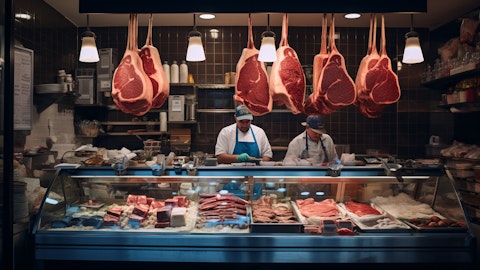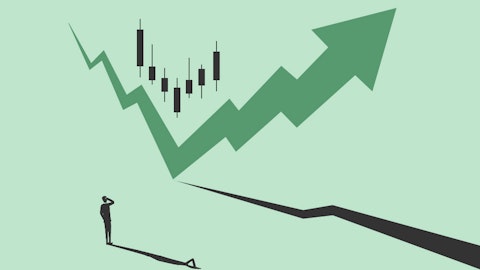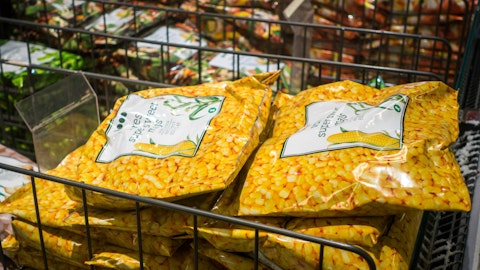In terms of — on the expense side of the house, disciplined expense management, our team has already directed an effort to reduce the structural expense by $100 million. We are on pace and we’ve begun building additional pipeline for future periods. In terms of working your way down to the P&L on the tax rate side, it’s 24.5%, no change. There’s a slight step up on interest expense of roughly $20 million attached to the $500 million of additional share repurchase. If you net it to impact together, so Jeff, I think your question is what is the accretion on EPS? There is a net accretion of roughly $0.05 or so net of the interest expense increase coupled with the retirement of the shares. So that is the $0.05 impact that you can expect for the fiscal year.
With that said, with all the intra-working variables, we are reiterating and reconfirming our full year guide of $4.20 to $4.40 with the midpoint of 7% growth versus last year.
Jeff Bernstein: Thank you.
Operator: The next question comes from Mark Carden with UBS. Please go ahead.
Mark Carden: Good morning. Thanks so much for taking the question. So I wanted to dig into your sales force additions to date. I know you said it’s going to be a bit of a ramp, but how is the initial progress going relative to your expectations? And then how are competitor hires having? Are they having much of an impact on your ability to really find enough high-quality salespeople? Thanks.
Kevin Hourican: Good morning, Mark. We’re really pleased with the progress that we’re making. And those efforts began in Q2, I want to be clear about this. So in the early innings, we haven’t quoted publicly the exact number of people we’re hiring, but it’s a significant number. We are not having a challenge with hiring and filling our classes. They are roster classes that we fill, and we put them through a very, very robust industry-leading training program. As it relates to competitive forces and the impact on our ability to hire, we’re not having challenges filling the positions. That’s my answer. We don’t just go to a competitor, if you will. That is a source of talent. We also go to restaurants. We go to culinary schools.
We’re looking for people that are food eccentric that are good at selling have a passion for this industry. We can train them on our tools. We can train them on our selling systems and process, and we can train them to scale them up to be what they are, which is the best in the industry, and that’s from our Net Promoter Score. So we’re not having a difficult time filling our classes. We’re really pleased with the first cohorts. We are on track to be able to hit the targeted hiring rate. And as I said before, that positively impacts 2025 from a growth perspective. Mark, back to you if you have any follow-up.
Mark Carden: Great. And then my follow-up is going to be related to M&A. You guys closed on Edward Don about two months ago. How is that early integration gone relative to your expectations? And then in December, you guys announced a small acquisition with Ready Chef in Ireland. Was that one simply a situation where the economics were just too good to pass up? Or does it signal a shift in strategy that you guys might be more open to international bolt-on or even larger scale M&A there?
Kevin Hourican: Hey, Mark, I appreciate the question. Let me just start with Edward Don, which is the significant transaction that we’ve done this fiscal year. I want to be really clear on the numbers that we quoted today. So one month of sales and profit are in the numbers that we described, but from a volume perspective because I know that’s a question some may have, we have not included Edward Don volume in our case growth figures at this time. So the growth in cases of 3.4 in total and 2.9 in local is pure Sysco, not including Don. I just want to be really clear about that. As it relates to the early innings, I was just up in Chicago last week. We had a great day with Steve Don and his leadership team and our leaders talking about the synergy capabilities between the two companies, we can purchase better together, buying product at a better and more affordable cost.
We can target joint customers more effectively. So we have large national sales, restaurant customers or hospitality customers of Sysco that aren’t currently customers have Don and vice versa. Don has some really big customers that Sysco’s not the food service distributor, so we can sell together in a joint proposition. And then there’s this huge opportunity longer term to take that equipment and sales, product, category and have it shoppable on Sysco’s digital platforms, deliverable on either a Don truck or perhaps some day to a local small mom-and-pop customer on a Sysco truck. We’re really excited, not just about the $1.3 billion in profitable top line we acquired through Don, we’re very excited about how we can grow that business meaningfully for years to come.
And I know Steve Don and his team are equally as excited. As it relates to Ready Chef in Ireland, just keep in context, it’s a much smaller countries. So the size of that acquisition is actually compelling for the country that it’s in. And what it was, was a fresh point like entity. So to be crystal clear, in Ireland, we did not have a fresh cut bespoke produce business and purchasing Ready Chef gives us what I’ll call from our US perspective, that FreshPoint capability. We’re running the Sysco play. That’s the headline. It’s not a change in strategy. Our strategy is in each of the major countries that we compete within, we will run the Sysco play, which is to be the leader in broadline into bolt-on specialty capabilities over time, so we can sell around the room for the customers that we serve and do so profitably.
So we’re excited about that acquisition in Ireland. Our leadership team in Ireland is top-notch, and I am very confident in their ability to profitably grow the business, better serve customers and increase penetration with existing customers within Ireland.
Mark Carden: Make sense. Thanks so much. Good luck guys.
Kevin Hourican: Thank you.
Operator: The next question comes from John Heinbockel with Guggenheim Securities.
John Heinbockel: So Kevin, can you talk about visit frequency and quality of visit, right? Those two — how you think about KPIs on each of those? And when you think about how that will move the sales needle, what are you looking? You’re looking for a certain amount of year-over-year growth in frequency, how do you quantify quality?
Kevin Hourican: John, great question. And for the quarter that we just completed, this is the biggest reason for our improvement from what was flat in Q1 to up 2.9 in Q2 is from what I call performance management, which is visit frequency, visit quality. The comp change poorly helped, but it was early innings and that will have a bigger impact in a year to go and the incremental SEs will impact 2025. We’ve not gone public with the numbers, the targets, John. But we have a very specific target of the number of visits that need to happen per week per SE, and we can track it. We can track it through this year end. And we were not where we needed to be. COVID had a disruption in a lot of things in life, and one of them was SE’s doing more of that work from a home office than we would have liked.





